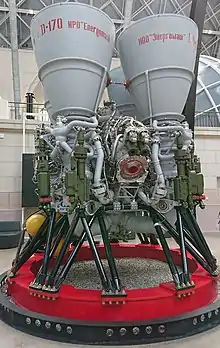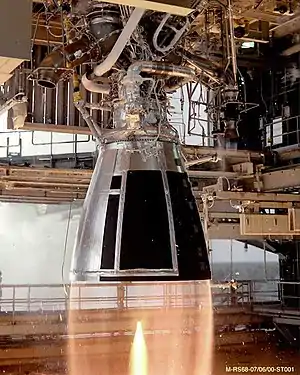 1:1 scale model of an RD-170 rocket engine, shown upside down | |
| Country of origin | Soviet Union/Russian Federation |
|---|---|
| First flight | 1985-04-13 |
| Manufacturer | NPO Energomash |
| Application | Main engine |
| Associated LV | Energia |
| Successor | RD-171M |
| Status | Retired |
| Liquid-fuel engine | |
| Propellant | LOX / RP-1 |
| Mixture ratio | 2.63 |
| Cycle | Oxidizer-rich staged combustion |
| Configuration | |
| Chamber | 4 |
| Nozzle ratio | 36.87 |
| Performance | |
| Thrust, vacuum | 7.90 MN (1,780,000 lbf) |
| Thrust, sea-level | 7.25 MN (1,630,000 lbf) |
| Throttle range | 100–40% |
| Thrust-to-weight ratio | 82:1 |
| Chamber pressure | 24.52 MPa (3,556 psi) |
| Specific impulse, vacuum | 337 s (3.30 km/s) |
| Specific impulse, sea-level | 309 s (3.03 km/s) |
| Burn time | 150 seconds |
| Dimensions | |
| Length | 4.0 m (160 in) |
| Diameter | 3.8 m (150 in) |
| Dry weight | 9,750 kg (21,500 lb) |
| Used in | |
| Energia | |
| References | |
| References | [1][2][3][4] |
The RD-170 (Russian: РД-170, Ракетный Двигатель-170, tr. Raketnyy Dvigatel-170) is the world's most powerful and heaviest liquid-fuel rocket engine. It was designed and produced in the Soviet Union by NPO Energomash for use with the Energia launch vehicle. The engine burns kerosene fuel and LOX oxidizer in four combustion chambers, all supplied by one single-shaft, single-turbine turbopump rated at 170 MW (230,000 hp) in a staged combustion cycle.[3][5]
Shared turbopump
Several Soviet and Russian rocket engines use the approach of clustering small combustion chambers around a single turbine and pump. During the early 1950s, many Soviet engine designers, including Valentin P. Glushko, faced problems of combustion instability while designing bigger thrust chambers. At that time, they solved the problem by using a cluster of smaller thrust chambers.
Variants
RD-170
The RD-170 engine featured four combustion chambers and was developed for use on the Energia launch vehicle – both the engine and the launch vehicle were in production only for a short time. Energia was launched twice. Each Energia vehicle had a core hydrolox stage, plus 4 Zenit boosters, each powered by one RD-170.
The engine was designed for 10 reuses but tests showed they could stand up to 20 burns.[6]
RD-171

Building on the technology from the Energia's liquid fuel booster the Zenit was developed, which uses a RD-170 variant, the RD-171. While the RD-171 had nozzles which swiveled on two axes, the RD-170's nozzles only swivel on one axis.[2] Models called the RD-172 and RD-173 were proposed, upgrades that would provide additional thrust, and the RD-173 proposal was finalized as the RD-171M upgrade in 2006.[2]
RD-171MV
A modification of RD-171M being developed for the Irtysh rocket. Unlike RD-171M it only uses Russian components and features a new control system.[7] First test sample was manufactured in early 2019[8] Tests were reported to have been successfully completed in September 2021.[9]
Dual-chamber derivative
The RD-180 uses only two combustion chambers instead of the four of the RD-170. The RD-180 used on the Atlas V replaced the three engines used on early Atlas rockets with a single engine and achieved significant payload and performance gains. This engine had also been chosen to be the main propulsion system for the first stage of the now cancelled Russian Rus-M rocket.[10]
Single-chamber derivative
The RD-191 is a single-chamber version used in the Russian Angara rocket.[11] Variants of RD-191 include RD-151 in South Korean Naro-1 rocket,[12] RD-181 in American Orbital ATK Antares rocket, and the proposed RD-193 for the Soyuz-2-1v project.[13]
Proposed variants
On 28 July 2011, NPO Energomash summarised the results of the work on Rus-M rocket engine and considered the possibility of construction several new variants of RD-170 family engines.[14] According to the information, new and proposed variants will be marked as:
- RD-180M for crewed Atlas V rocket (Not required, current RD-180 meets crewed Atlas V requirements.)[15]
- RD-180V for Rus-M rocket.
- RD-175 with 9800 kN thrust for proposed Energia-K rocket.
In 2017, Director General of RKK Energia Vladimir Solntsev referred to a "simplified" and "cheaper" version of the RD-171 engine in connection with the Soyuz-5 (Sunkar) project.[16]
Specifications
- 4 combustion chambers, 4 nozzles
- 1 set of turbines and pumps; turbine produces approximately 257,000 hp (192 MW); equivalent to the power output of 3 nuclear-powered icebreakers
- Ignition: pyrophoric start-up fuel capsule (triethylaluminium)[17]
- Vacuum thrust: 7,887 kN (1,773,000 lbf)
- Vacuum Isp: 338 s (3.31 km/s)
- Sea-level Isp: 309 s (3.03 km/s)
- Weight: 9,750 kilograms (21,500 lb)
- Thrust-to-weight ratio: 82
See also
References
- ↑ "RD-171M". NPO Energomash. Archived from the original on 3 March 2022.
- 1 2 3 Ponomarenko, Alexander. "ЖРД РД-170 (11Д521) и РД-171 (11Д520)" [RD-170 (11D521) and RD-171 (11D520)] (in Russian). Retrieved 2015-10-08.
- 1 2 Wade, Mark. "RD-170". Encyclopedia Astronautica. Archived from the original on April 15, 2002. Retrieved 2015-10-08.
- ↑ Krebs, Gunter Dick (2015-09-15). "Zenit family". Gunter's Space Page. Retrieved 2015-10-08.
- ↑ "South Korea to launch first space rocket on Aug. 19". Yonhap News Agency. 2009-08-25. Retrieved 2015-10-08.
- ↑ RD-170 Astronautix. Mark Wade
- ↑ "В НПО ЭНЕРГОМАШ СОЗДАН ЭТАЛОННЫЙ МАКЕТ ДВИГАТЕЛЯ РД-171 МВ" [Energomash has made a reference model of RD-171MV]. NPO Energomash (in Russian). 16 October 2018. Archived from the original on 2 January 2022.
- ↑ @Rogozin (February 8, 2019). "Первый двигатель РД-171МВ для новейшей ракеты среднего класса Союз-5 "Иртыш" собран на подмосковном "НПО Энергомаш" и готовится к огневым испытаниям" [First sample RD-171MV for Soyuz-5 Irtish manufactured in Energomash is ready for testing.] (Tweet) (in Russian) – via Twitter.
- ↑ Berger, Eric (9 October 2021). "Rocket Report: Next Falcon Heavy launch date set, Soyuz 5 engines clear tests". Ars Technica.
- ↑ Coppinger, Rob (2009-08-11). "The Bear's stars shine brighter". Flight International. Archived from the original on 14 August 2009.
- ↑ "Successful Tests of Angara Stage 1 Engine". Khrunichev. 2007-12-12. Archived from the original on 2007-12-30.
- ↑ "First launch of KSLV-1 is conducted". 25 August 2009. Archived from the original on 23 July 2011.
- ↑ Zak, Anatoly. "RD-193". russianspaceweb.com. Retrieved 2015-06-04.
- ↑ "Проведено заседание НТС" (in Russian). August 1, 2011. Archived from the original on September 30, 2011. Retrieved August 26, 2011.
- ↑ "Energomash 2011 catalog (Russian)". Roscosmos. Retrieved February 15, 2018.
- ↑ "Russia charts new path to super rocket". russianspaceweb.com. Retrieved February 15, 2018.
- ↑ "РД-170 (11Д521) и РД-171 (11Д520)".
